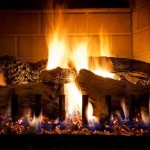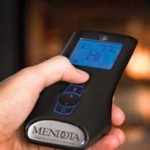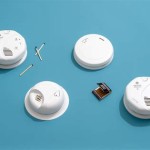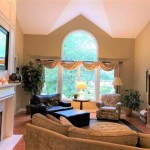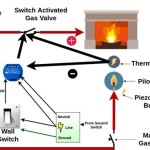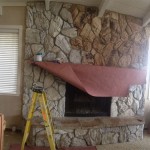Fireplace Design for Living Rooms: A Comprehensive Guide
The fireplace, historically a vital source of heat and light, has evolved into a significant design element in modern living rooms. It serves as a focal point, adding warmth, character, and a touch of elegance to the space. Choosing the right fireplace design requires careful consideration of several factors, including the room's architectural style, available space, fuel type, and personal preferences. This article provides a comprehensive overview of fireplace design options for living rooms, focusing on key aspects to consider for a successful and aesthetically pleasing outcome.
Selecting the Right Fireplace Style
The style of the fireplace should complement the overall aesthetic of the living room. A mismatch between the fireplace and the existing design can create a jarring and undesirable effect. Several distinct styles are popular, each offering a unique visual appeal.
Traditional Fireplaces: Characterized by ornate detailing, classic materials like brick and stone, and a generally formal appearance, traditional fireplaces often feature decorative mantels and hearths. These designs typically suit homes with a more established and conventional style. Details like corbels, intricate carvings, and marble surrounds are common elements. They evoke a sense of established history and can be particularly effective in grand or historically inspired living rooms.
Modern Fireplaces: Modern fireplaces embrace clean lines, minimalist designs, and a focus on functionality. Materials like concrete, metal, and glass are frequently used. These fireplaces often incorporate geometric shapes and a sleek, uncluttered look. They are ideal for contemporary homes with a minimalist or industrial design aesthetic. Modern fireplaces might feature linear shapes, frameless designs, or integrated shelving for a streamlined appearance.
Rustic Fireplaces: Rustic fireplaces evoke a sense of warmth, nature, and cozy comfort. They often incorporate natural materials like reclaimed wood, river rock, and fieldstone. The designs emphasize texture and imperfections, creating a relaxed and inviting atmosphere. Rustic styles work well in homes with a farmhouse, cabin, or country-inspired decor. Features such as exposed brick, rough-hewn beams, and stacked stone are hallmarks of this style.
Transitional Fireplaces: A transitional fireplace blends elements of both traditional and modern styles. This style avoids being overly ornate or excessively minimalist, creating a balanced and timeless look. It often features clean lines with subtle detailing and utilizes a mix of materials. Transitional fireplaces are versatile and can adapt to a variety of design schemes, providing a bridge between classic and contemporary aesthetics. They allow for flexibility in incorporating different textures and finishes, ensuring a cohesive design.
Beyond these core styles, other variations exist, such as coastal, industrial, and eclectic designs, each offering a distinct character. The key is to choose a style that resonates with the homeowner's personal preferences and harmonizes with the existing living room decor.
Choosing the Right Fuel Type for Your Fireplace
The fuel type is another crucial consideration when selecting a fireplace. The choice depends on factors such as environmental concerns, convenience, cost, and availability of fuel sources. The following are the most common fuel types used in fireplaces.
Wood-Burning Fireplaces: Wood-burning fireplaces offer a traditional ambiance and a genuine crackling fire. They require a readily available source of firewood and proper ventilation to ensure safe and efficient operation. The primary disadvantage is the particulate matter released into the atmosphere, leading to concerns about air quality. Additionally, wood-burning fireplaces require regular cleaning and maintenance to prevent the buildup of creosote, a flammable substance that increases the risk of chimney fires. These fireplaces necessitate proper storage for firewood, which can consume space and potentially attract pests.
Gas Fireplaces: Gas fireplaces are a convenient and clean-burning alternative to wood. They operate on natural gas or propane and offer instant ignition and adjustable flame heights. Gas fireplaces require professional installation by a qualified technician to ensure proper connection to the gas line and safe venting. They produce less particulate matter than wood-burning fireplaces and are generally more energy-efficient. However, gas fireplaces do not offer the same authentic ambiance as wood-burning options, and the cost of gas can fluctuate depending on market conditions. Direct vent gas fireplaces, which vent directly to the outside, are often preferred for their safety and efficiency.
Electric Fireplaces: Electric fireplaces are the most convenient and environmentally friendly option. They do not require any venting and can be easily installed by simply plugging them into an electrical outlet. Electric fireplaces use heating elements to generate heat and often feature realistic flame effects to mimic the appearance of a real fire. While they do not provide the same level of heat as wood-burning or gas fireplaces, they are an excellent choice for supplemental heating and aesthetic purposes. Electric fireplaces are also ideal for apartments or homes where venting is not feasible or permitted. They are available in various styles, from traditional mantels to modern wall-mounted units, offering versatility in design.
Ethanol Fireplaces: Ethanol fireplaces burn liquid ethanol fuel, producing a clean and ventless flame. They are a relatively new option that is gaining popularity for its modern aesthetic and ease of installation. Ethanol fireplaces do not require a chimney or flue, making them suitable for a variety of spaces. However, they produce less heat than traditional fireplaces and require a consistent supply of ethanol fuel. Safety precautions must be followed when handling and storing ethanol fuel, as it is flammable. Ethanol fireplaces are often used as decorative accents and can be easily moved from room to room.
Each fuel type presents its unique advantages and disadvantages, and the best choice depends largely on individual needs and preferences. Factors such as budget, environmental impact, and convenience should be carefully considered before making a decision.
Incorporating Surrounding Design Elements
The fireplace is more than just a functional appliance; it's a design element that interacts with the surrounding space. The surrounding design elements can enhance the fireplace’s impact and create a cohesive and visually appealing living room.
Mantel Design: The mantel provides a visual shelf above the fireplace opening, providing a platform for displaying decorative items like artwork, photographs, and candles. The mantel should complement the fireplace style and the overall decor of the living room. Simple, clean-lined mantels work well with modern fireplaces, while more ornate and detailed mantels are suitable for traditional designs. Reclaimed wood mantels add a rustic touch, while sleek metal mantels enhance a contemporary aesthetic. The mantel can be customized with various finishes and materials to match the surrounding decor. The height and depth of the mantel should be carefully considered to ensure a balanced and proportionate appearance.
Hearth Considerations: The hearth is the non-combustible area directly in front of the fireplace opening. It serves as a protective barrier against sparks and embers. The hearth can be made of various materials, including brick, stone, tile, or concrete. The size and shape of the hearth should be proportionate to the fireplace dimensions and the surrounding space. A larger hearth provides a more substantial presence, while a smaller hearth offers a more minimalist look. The color and texture of the hearth should complement the fireplace surround and the overall decor of the living room. In modern designs, the hearth may be flush with the floor or raised slightly to create a visual distinction.
Surround Materials and Textures: The surround encompasses the area immediately surrounding the fireplace opening, defining its form and adding visual interest. Common surround materials include brick, stone, tile, wood, and metal. The choice of material and texture can significantly impact the overall appearance of the fireplace. Brick surrounds evoke a traditional and rustic feel, while stone surrounds add a natural and organic element. Tile surrounds offer a wide range of colors and patterns, allowing for customization and creative expression. Wood surrounds provide warmth and texture, while metal surrounds create a sleek and modern aesthetic. The surround should be carefully selected to complement the fireplace style and the surrounding decor. The texture of the material can also add visual interest, with options ranging from smooth and polished to rough and textured finishes.
Lighting Strategies: Proper lighting can enhance the fireplace’s impact and create a warm and inviting atmosphere. Recessed lighting, sconces, and accent lighting can highlight the fireplace and its surrounding details. Downlights can illuminate the mantel and create a focal point, while uplights can accentuate the texture of the surround. Dimmable lighting allows for adjusting the ambiance based on the desired mood. Candlelight can also be used to create a soft and romantic glow. Strategic placement of lighting fixtures is essential to avoid glare and create a balanced and harmonious lighting scheme. The color temperature of the lighting should be consistent with the overall decor of the living room.
Accessories and Decor: The accessories and decor placed around the fireplace can personalize the space and reflect the homeowner's style. Artwork, photographs, vases, and other decorative items can be displayed on the mantel and hearth. A strategically placed rug can define the seating area and add warmth and texture to the space. Throw pillows and blankets can enhance the comfort and coziness of the living room. The accessories and decor should be carefully selected to complement the fireplace style and the overall decor of the living room. Avoid cluttering the mantel and hearth, as this can detract from the fireplace’s visual impact. The accessories should be arranged in a balanced and harmonious manner to create a visually pleasing composition.
Careful consideration of these surrounding elements will maximize the fireplace's aesthetic contribution to the living room, creating a welcoming and visually appealing space.

Sprucing Up Your Home S Living Room With Fireplace By Expert

40 Best Fireplace Décor Ideas Mantel

Fireplace Design Ideas For Your Home Designcafe

36 Fireplace Decor Ideas Modern Mantel

Unveiling The 63 Best Modern Fireplace Design Ideas In 2024 Living Room Trendy Rooms

Lovely Painted Brick Fireplaces In The Living Room Beautiful Homes

36 Fireplace Decor Ideas Modern Mantel

7 Inspirational Living Room Layout Ideas

Custom Built Fireplace Ideas For A Living Room

50 Fireplace Ideas To Give Your Room That Special Spark
Related Posts

